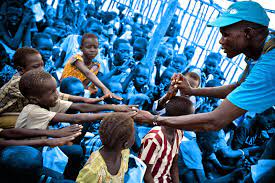Ololade Omosan-Agie
The United Nation Children’s Fund has stated that young people living in Nigeria are among those most at risk of the impacts of climate change, threatening their health, education and protection.
UNICEF in its ‘The Climate Crisis Is a Child Rights Crisis’ report launched on Friday, ranked Nigeria as the second among the 33 countries classified as “extremely high-risk”.
The report ranks countries based on children’s exposure to climate and environmental shocks, such as cyclones and heatwaves, as well as their vulnerability to those shocks, based on their access to essential services.
It states, “Aproximately one billion children, nearly half the world’s 2.2 billion children live in one of the 33 countries classified as “extremely high-risk”.
“The findings reflect the number of children impacted today; figures likely to get worse as the impacts of climate change accelerate.
“Nigeria ranks second among these countries, together with Chad, and just after the Central African Republic (ranked first).”
According to the report, Nigerian children are highly exposed to air pollution and coastal floods.
It also stated that investments in social services, particularly child health, nutrition and education can make a significant difference in safeguarding the future from the impacts of climate change.
Commenting on the report, UNICEF Nigeria Representative, Peter Hawkins said, “Nigeria is not immune to the effects of climate change, but we can act now to prevent it from becoming worse.
“We need to invest in the services children depend on to survive and thrive, such as water, healthcare and education to protect their futures from the impacts of a changing climate and degrading environment.”
The Children’s Climate Risk Index (CCRI) reveals that globally, 240 million children are highly exposed to coastal flooding, 330 million exposed to riverine flooding, 1 billion children are highly exposed to exceedingly high levels of air pollution.
“400 million children are highly exposed to cyclones; 600 million children are highly exposed to vector borne diseases: 815 million children are highly exposed to lead pollution.
“820 million children are highly exposed to heatwaves and 920 million children are highly exposed to water scarcity.
“An estimated 850 million children;1 in 3 worldwide – live in areas where at least four of these climate and environmental shocks overlap. As many as 330 million children 1 in 7 worldwide live in areas affected by at least five major shocks,” it added.
The report also reveals a disconnect between where greenhouse gas emissions are generated, and where children are enduring the most significant climate-driven impacts.
Hawkins noted that the frightening environmental changes ongoing across the planet are being driven by a few but experienced by many.
She further said that without the urgent action required to reduce greenhouse gas emissions, children will continue to suffer the most.
She added, “Children know climate change is a threat to their future, and they are calling on world leaders to act. So far, too little has been done, but we still have time. We must urgently reduce greenhouse gas emissions and work as a global community to build a better world for all children.
 The Commerce Africa African Reneissance
The Commerce Africa African Reneissance




